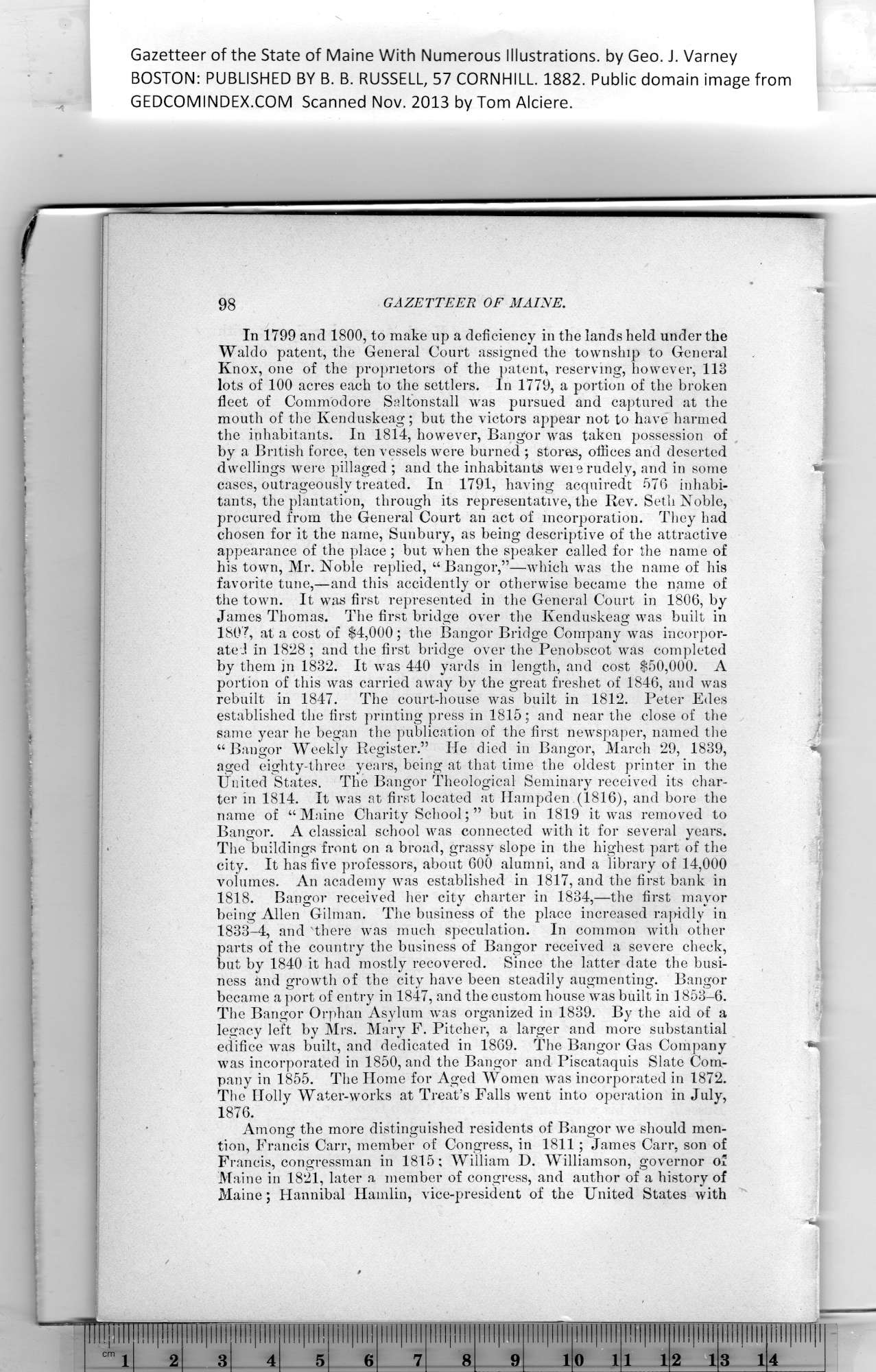|
Gazetteer of the State of Maine With Numerous Illustrations, by Geo. J. Varney
BOSTON: PUBLISHED BY B. B. RUSSELL, 57 CORNHILL. 1882. Public domain image from
98 GAZETTEER OF MAINE.
In 1799 and 1800, to make up a deficiency in the lands held under the
Waldo patent, the General Court assigned the township to General
Knox, one of the proprietors of the patent, reserving, however, 113
lots of 100 acres each to the settlers. In 1779, a portion of the broken
fleet of Commodore Saltonstall was pursued and captured at the
mouth of the Kenduskeag; but the victors appear not to have harmed
the inhabitants. In 1814, however, Bangor was taken possession of
by a British force, ten vessels were burned ; stores, offices and deserted
dwellings were pillaged ; and the inhabitants were rudely, and in some *4
cases, outrageously treated. In 1791, having acquiredt 576 inhabi-
tants, the plantation, through its representative, the Rev. Seth Noble,
procured from the General Court an act of incorporation. They had
chosen for it the name, Sunbury, as being descriptive of tbe attractive
appearance of the place ; but when the speaker called for the name of
his town, Mr. Noble replied, “ Bangor,”—which was the name of his
favorite tune,—and this accidently or otherwise became the name of
the town. It was first represented in the General Court in 1806, by
James Thomas. The first bridge over the Kenduskeag was built in
1807, at a cost of $4,000; the Bangor Bridge Company was incorpor-
ated in 1828 ; and the first bridge over the Penobscot was completed
by them in 1832. It was 440 yards in length, and cost $50,000. A
portion of this was carried away by the great freshet of 1846, and was
rebuilt in 1847. The court-house was built in 1812. Peter Edes
established the first printing press in 1815; and near the close of the
same year he began the publication of the first newspaper, named the
“Bangor Weekly Register.” He died in Bangor, March 29, 1839,
aged eighty-three years, being at that time the oldest printer in the
United States. The Bangor Theological Seminary received its char-
ter in 1814. It was at first located at Hampden (1816), and bore the
name of “Maine Charity School; ” hut in 1819 it was removed to
Bangor. A classical school was connected with it for several years.
The buildings front on a broad, grassy slope in the highest part of the
city. It has five professors, about 600 alumni, and a library of 14,000
volumes. An academy was established in 1817, and the first bank in
1818. Bangor received her city charter in 1834,—the first mayor
being Allen Gilman. The business of the place increased rapidly in
1833-4, and there was much speculation. In common with other
parts of the country the business of Bangor received a severe check,
but by 1840 it had mostly recovered. Since the latter date the busi-
ness and growth of the city have been steadily augmenting. Bangor
became a port of entry in 1847, and the custom house was built in 1853-6.
The Bangor Orphan Asylum was organized in 1839. By the aid of a
legacy left by Mrs. Mary F. Pitcher, a larger and more substantial
edifice was built, and dedicated in 1869. The Bangor Gas Company
was incorporated in 1850, and the Bangor and Piscataquis Slate Com-
pany in 1855. The Home for Aged Women was incorporated in 1872.
The Holly Water-works at Treat’s Falls went into operation in July,
i876.
Among the more distinguished residents of Bangor we should men-
tion, Francis Carr, member of Congress, in 1811; James Carr, son of
Francis, congressman in 1815; William D. Williamson, governor of
Maine in 1821, later a member of congress, and author of a history of
Maine; Hannibal Hamlin, vice-president of the United States with
PREVIOUS PAGE ... NEXT PAGE
This page was written in HTML using a program written in Python 3.2
|
